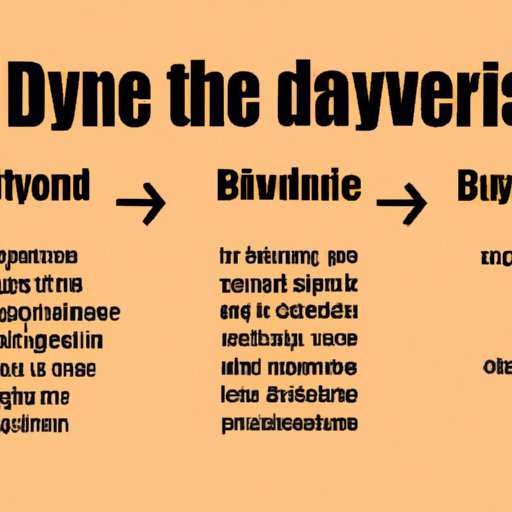Introduction
Dividends are payments made by a company to its shareholders. They are typically paid out quarterly and are usually a portion of the company’s profits. This article will explore the basics of dividends, the different types of dividends, how dividend yield is calculated, the tax implications of receiving dividends, and strategies for investing in companies that pay dividends.
Explaining the Basics of Dividends
Before diving into the details of dividends, it’s important to understand a few key concepts.
What are dividends?
Dividends are payments made by a company to its shareholders, usually as a portion of the company’s profits. They are typically paid out quarterly, although some companies may pay out dividends annually or semi-annually. Dividends are typically expressed as a percentage of the current stock price. For example, if you own 100 shares of a company with a current stock price of $50 per share and the company pays a dividend of 2%, you would receive a total dividend payment of $100 ($50 x 2%).
Types of dividends
There are several different types of dividends. The most common type is a cash dividend, which is a payment made by the company in cash. Other types of dividends include stock dividends, property dividends, and special dividends. A stock dividend is a payment made in the form of additional shares of the company’s stock. A property dividend is a payment made in the form of assets such as real estate or equipment. A special dividend is a one-time payment made outside of the normal dividend schedule.
Who receives dividends?
Dividends are typically paid out to shareholders who own common stock in the company. However, some companies may also pay dividends to holders of preferred stock. Preferred stockholders generally have priority when it comes to dividends, meaning they will receive their dividend payments before common stockholders.

Understanding the Different Types of Dividends
Now that we’ve covered the basics of dividends, let’s take a closer look at the different types of dividends.
Cash dividends
As mentioned above, cash dividends are the most common type of dividend. They are payments made by the company in cash, usually on a quarterly basis. Cash dividends are typically expressed as a percentage of the current stock price.
Stock dividends
A stock dividend is a payment made in the form of additional shares of the company’s stock. For example, if a company declares a 10% stock dividend, each shareholder will receive an additional 10% of the number of shares they currently own. So if you own 100 shares of a company, you will receive an additional 10 shares after the stock dividend has been declared.
Property dividends
A property dividend is a payment made in the form of assets such as real estate or equipment. These types of dividends are less common than cash and stock dividends, and may be used as a way for companies to liquidate certain assets without having to sell them on the open market.
Special dividends
A special dividend is a one-time payment made outside of the normal dividend schedule. Special dividends are typically used to reward shareholders for their loyalty, or to return excess capital to shareholders.

The Impact of Dividends on Stock Price
It’s important to understand the impact that dividends can have on a company’s stock price. Let’s take a look at two key factors: dividend yield and dividend policy.
Relationship between dividend yield and stock price
The dividend yield is the ratio of a company’s annual dividend payments divided by its current stock price. Generally speaking, a higher dividend yield indicates a higher potential return for investors, and as a result, the stock price may increase as investors buy up more shares. Conversely, a lower dividend yield may lead to a decrease in the stock price as investors look for higher returns elsewhere.
Impact of dividend policy on share price
The dividend policy of a company can also have an impact on its stock price. Companies with a history of increasing dividends tend to have higher stock prices, as investors know they can count on a steady stream of income from the company. On the other hand, companies that cut or eliminate their dividend payments may see their stock prices decline as investors become wary of investing in the company.
How to Calculate Your Dividend Yield
Now that we’ve discussed the impact of dividends on stock price, let’s take a look at how to calculate your dividend yield.
Formula for calculating dividend yield
The formula for calculating dividend yield is relatively simple: divide the annual dividend payment by the current stock price. For example, if a company pays an annual dividend of $1.00 per share and the current stock price is $50.00 per share, the dividend yield would be 2% (1.00/50.00 = 0.02).
Factors that affect dividend yield
It’s important to note that there are several factors that can affect a company’s dividend yield. For example, if the company’s stock price increases, the dividend yield will decrease. Similarly, if the company’s dividend payment increases, the dividend yield will increase. It’s important to keep these factors in mind when calculating your dividend yield.

Tax Implications of Receiving Dividends
In addition to understanding the basics of dividends and how to calculate your dividend yield, it’s important to understand the tax implications of receiving dividends. Let’s take a look.
Overview of taxation of dividends
In the United States, dividends are generally subject to taxation. The amount of tax you owe on dividends depends on several factors, including your filing status and income level.
How dividend income is taxed
For most taxpayers, dividend income is taxed at their ordinary income tax rate. However, if you are in the 10% or 12% tax bracket, you may be eligible for the 0% tax rate on qualified dividend income. Additionally, if you are in the 22%, 24%, 32%, 35%, or 37% tax bracket, you may be eligible for the 15% tax rate on qualified dividend income. It’s important to consult with a tax professional to determine your eligibility for these tax rates.
Strategies for Investing in Companies That Pay Dividends
Finally, let’s take a look at some strategies for investing in companies that pay dividends.
Advantages of investing in companies that pay dividends
Investing in companies that pay dividends can be a great way to generate a steady stream of passive income. Not only do you get the benefit of capital appreciation, but you also get regular dividend payments. Additionally, companies that pay dividends tend to be more stable and less volatile than companies that don’t pay dividends.
Strategies for selecting dividend-paying stocks
When selecting dividend-paying stocks, it’s important to look for companies with a track record of paying consistent dividends. Dividend-paying stocks can also be screened based on dividend yield, payout ratio, and other metrics. It’s also important to research a company’s financials to make sure it is financially sound and able to continue paying dividends in the future.
Conclusion
Dividends are payments made by a company to its shareholders, usually as a portion of the company’s profits. There are several different types of dividends, including cash dividends, stock dividends, property dividends, and special dividends. It’s important to understand the impact of dividends on stock price, how to calculate your dividend yield, and the tax implications of receiving dividends. Finally, there are several strategies for investing in companies that pay dividends, including looking for companies with a track record of paying consistent dividends and screening stocks based on dividend yield and other metrics.
(Note: Is this article not meeting your expectations? Do you have knowledge or insights to share? Unlock new opportunities and expand your reach by joining our authors team. Click Registration to join us and share your expertise with our readers.)
